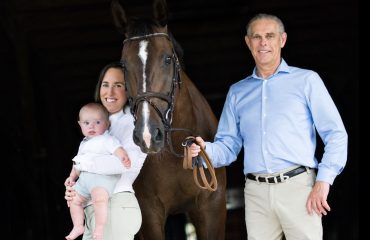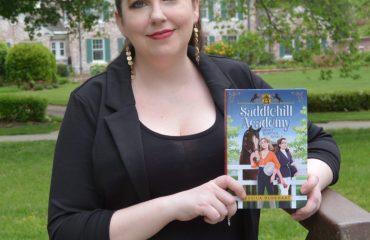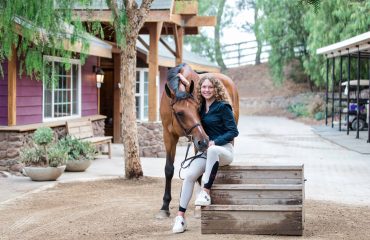
Dianne and Encore, owned by Sterling Stables, was the Champion Conformation and Working Hunter from 1969 to 1972.
United States Hunter Jumper Association Board Member and Treasurer Dianne Johnson has a long history of service to the horse industry. From getting hooked on horses through Girl Scouts to horse showing with her companion pet monkey to winning the Grand Prix at Calgary 12 times, the lifelong equestrian from the Pacific Northwest possesses colorful stories and a zest for adventure. Sidelines had the chance to talk to Dianne about her interesting past, her current horse show management and vision for the future of horse shows in the United States.
How did you get into horses? Did you have a horsey family?
Well to be perfectly honest, I lived in the city, my father was an alcoholic and I was always afraid to bring people home, so I didn’t have much of a social life. I went out for my Girl Scout badge in horsemanship — this is really corny — and I got hooked. I was one of those who went out and cleaned tack and stalls to be able to ride for an hour. I kind of did that all through high school and then my grandfather bought me a horse, and I’d take school horses and show them, and I worked my way up through the ranks.
My grandfather was in real estate and he had some money; my mother got hooked on it too, so after my parents divorced, my grandfather bought my mother and me a stable and I turned professional. I started training horses and teaching people and the whole nine yards. Our stable, Sterling Stable, was outside of Seattle. I showed extensively. I don’t usually say this, but I won the Grand Prix at Calgary 12 consecutive years from 1960–1972 and I also won the World Championship Jumper Sweepstakes two years in a row.
There was a trainer in Oregon named Johnny Johnson — we were competitors — and he thought that I was a brat and I thought he was a playboy and we were both right. We finally went out on a date and got married six months later. Johnny had a stable in Portland and I said, “You decide where we should live.” He decided on Washington because it was more cosmopolitan.
Do you still have that stable?
No, it was in a residential district in Seattle, and of course the houses moved in. It’s the same old story: civilization moved in and we got offers to sell it, so we bought another stable outside of Seattle and then somebody came along and wanted to buy that. So then we downscaled and leased a barn and we started buying and selling horses and then about that time somebody asked me to manage a horse show and I started managing horse shows.

Now a horse show manager, Dianne spent years as a rider and trainer including competing Ebony Witch at the Calgary International Horse Show in 1968.
On a completely different note: I heard you had a pet monkey at one time. How does one end up with a pet monkey?
When I was 14 or 15, my grandfather took me and a cousin to see a relative who had a very fancy guest ranch in Santa Barbara, California. While we were there, he took us to L.A. to sightsee and we went by a pet store. I said, “I want that monkey!” and so he bought it for me. We took it back to the motel and turned it loose and it took me an hour to catch him! He was jumping from the bed to the drapes.
That was Bingo and I took him home, and trained him like a dog. We put him in a kennel at night and we gave him a washcloth and he covered himself up and would go to sleep. I house broke him like a dog. We’d always have a dish of candy on the coffee table and his big game was to sneak up and start to reach for the candy. We’d say, “No Bingo!” and then he’d scream and yell. I taught him how to ride. I’d put him on one horse and I’d get on another one and I’d jump — kids, we were young and crazy — we’d go around and jump. I’d lead the horse. Later, I also had a pet donkey I taught to jump.
So what kind of monkey was Bingo?
He was a Capuchin, the little brown and black kind with the long tail. I’d put him on my shoulder and he’d wrap his tail around me. He went to all the horse shows with me and he wouldn’t run away. He was like a pet dog. It was really cool.
How did you get involved managing horse shows?
My husband and I had the stable here in Seattle and we decided the industry needed a really good outside horse show — a spectator show held on grass. Another couple and Johnny and I started the Evergreen Classic, which turned into a huge charity horse show. Then it ended up being a charity horse show for Fred Hutchison Cancer Research and Seattle Opera and some pretty famous charities. And that’s how I started. Then it branched out to other horse shows and now I manage eight shows. I do not own a horse show but I manage them for either organizations or charities.
What’s the most challenging and rewarding aspect of being a horse show manager?
I manage a special horse show in Bend, Oregon: the Oregon High Desert Classics. It benefits J Bar J Youth Services and it’s on the grounds of the charity, which is a school for troubled boys who’ve committed juvenile offenses like shoplifting or stealing cars. They receive counseling and go to school there. I do two horse shows, two weeks in July. It’s their only fundraiser, and the exhibitors actually get to see where their money goes.
They have another school for girls. The boys all dress up and wear T-shirts and empty garbage and work the horse show, and the girls wear pink T-shirts and they bus all the parties we have, so they are very visible. To my knowledge, it’s the only horse show in the United States that the exhibitor gets to deduct 20 percent of their expenses — it’s tax deductible. It’s all on grass and the facility gets upgraded every year — it’s a cool horse show!
Does that draw a lot of people from the community?
Yes, you’ll wake up almost every morning and on the front page of the local newspaper is a picture of a horse. They televise the Saturday night grand prix and there will be people standing 10 deep around the arena — the whole town turns out for it. We have a big VIP area with a sit-down dinner and it’s sold out. It’s fun to watch because the residents — the spectators — wait for it all year long. This is the 27th year and I’ve managed them all.

Ebony Witch, owned by Johnny and Dianne Johnson and their Sterling Stables, won the Grand Prix of Calgary four years in a row — from 1966 to 1969.
What inspires you the most about the people and/or the horses that you get to know?
To me, it’s a different sport than any of the other ones because you have a horse involved and you have to adjust to the horse’s disposition, and they have moods just like we have moods. And watching the kids come along — to me, it’s really wonderful — and where the parents get involved and if it’s a family, it’s something they can all do. I really enjoy that aspect of it.
What’s your secret to staying organized?
I just have a plain old calendar that the Humane Society sends me every year, and I just put it all on that. I’m a little anal about being organized so I work on everything throughout the year. For instance, I’ve already hired all my officials for next year’s horse show. I don’t do anything last-minute. And I do have another life. I travel, and I go play bridge and mahjong and tennis and golf. I think you have to do it for your sanity. I keep telling people in the horse business, ‘You need another life, guys!” This business can be pretty intense and get you out of whack.
What are some of your favorite destinations?
Africa. We went to South Africa and did safaris and it was a trip of a lifetime. In fact, I travel with Julie Winkel and she said it was a “life-changing” experience. We did safaris where we got within three feet of tigers and elephants — it was incredible.
What are some of the behind-the-scenes things that have to be done for a horse show to happen that the riders or general public would never think of?
In Bend, Oregon, we start with a grass field and we have to erect everything from the stalls to the rings to the announcer’s booth to the VIP area. Before we put the grass fields in, it was a pig pasture. It’s an amazing scene where that happens. Figuring out stabling is always a challenge. Most people that come and show just come and show and go home and they don’t ever think about what it takes — the paperwork, the organization — but that’s fine, that’s what it’s there for, so they can enjoy it.
What’s the greatest challenge for horse shows in this age of so much technology and urbanization?
I have to say, one of my biggest pet peeves is that I think we’re very guilty of not telling the general public about the wonderful sport that we have — they don’t even know it exists. So many horse shows have become factories, and they’re making money and we’ve forgotten to tell everybody that we have something wonderful.
A couple of years ago, I took about 10 of my girlfriends to a horse show and they said, “Wow! We had no idea something like this existed.” But we’ve got a couple shows now, like the Central Park Horse Show and the Longines L.A. Masters, that are spectator horse shows, which I think are great because we need to bring new people into it. We tell each other, we tell everyone in our own industry, but we’re kind of in our own little cocoon that we need to branch out to the rest of the world.
About the writer: Susan Friedland-Smith of North Tustin, California, is a middle school teacher and equestrian lifestyle blogger at Saddle Seeks Horse. Check out her blog saddleseekshorse.com or follow on Instagram @SaddleSeeksHorse.
Photos courtesy of Dianne Johnson













